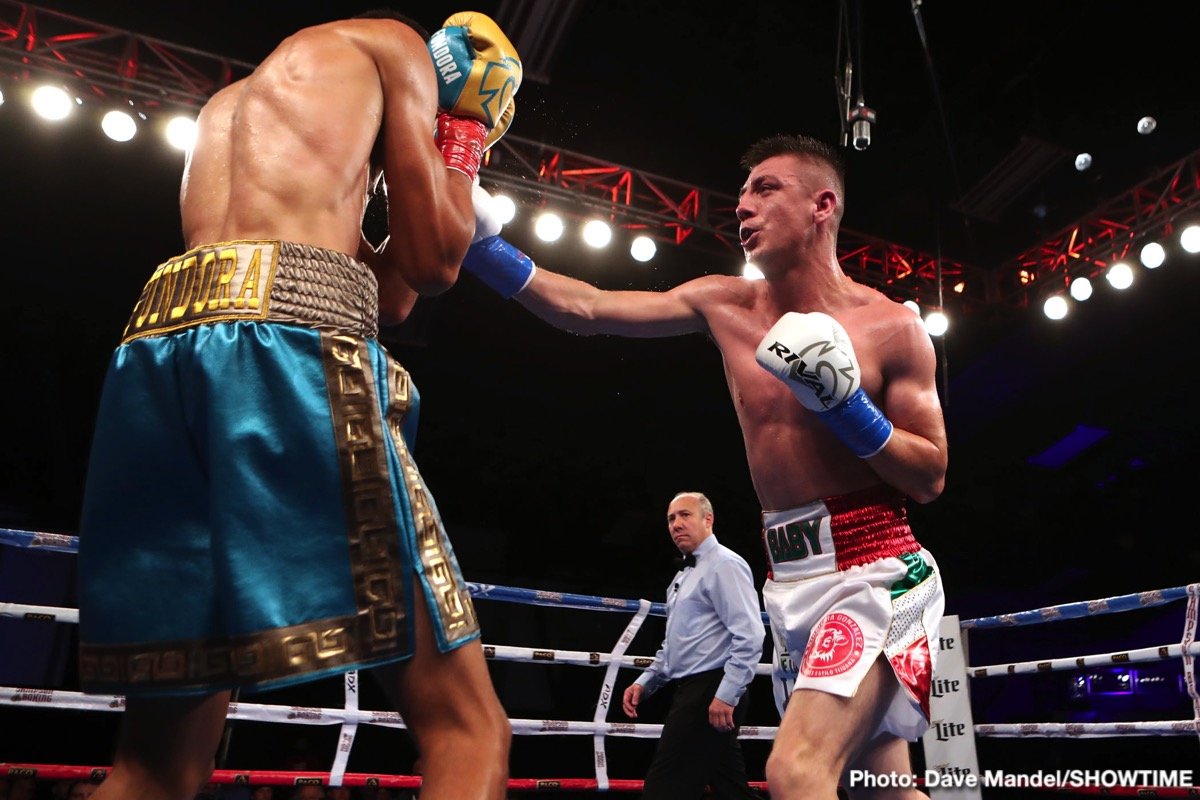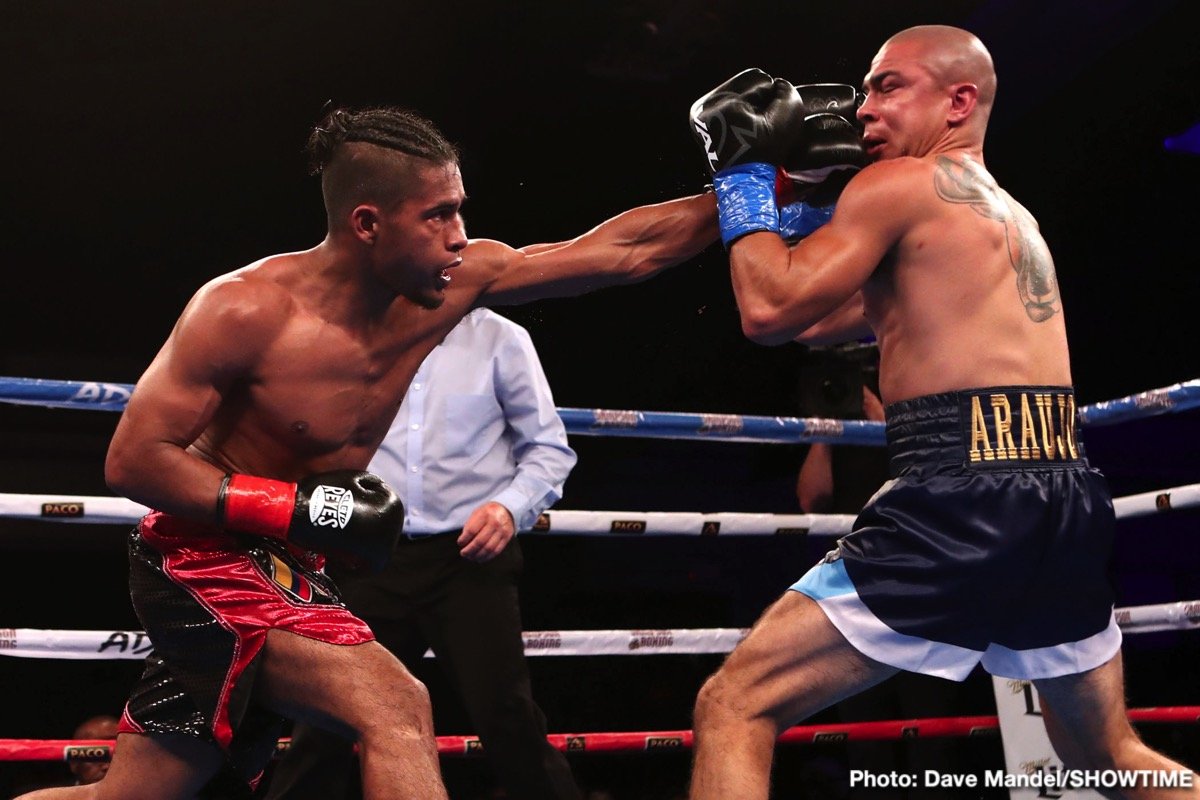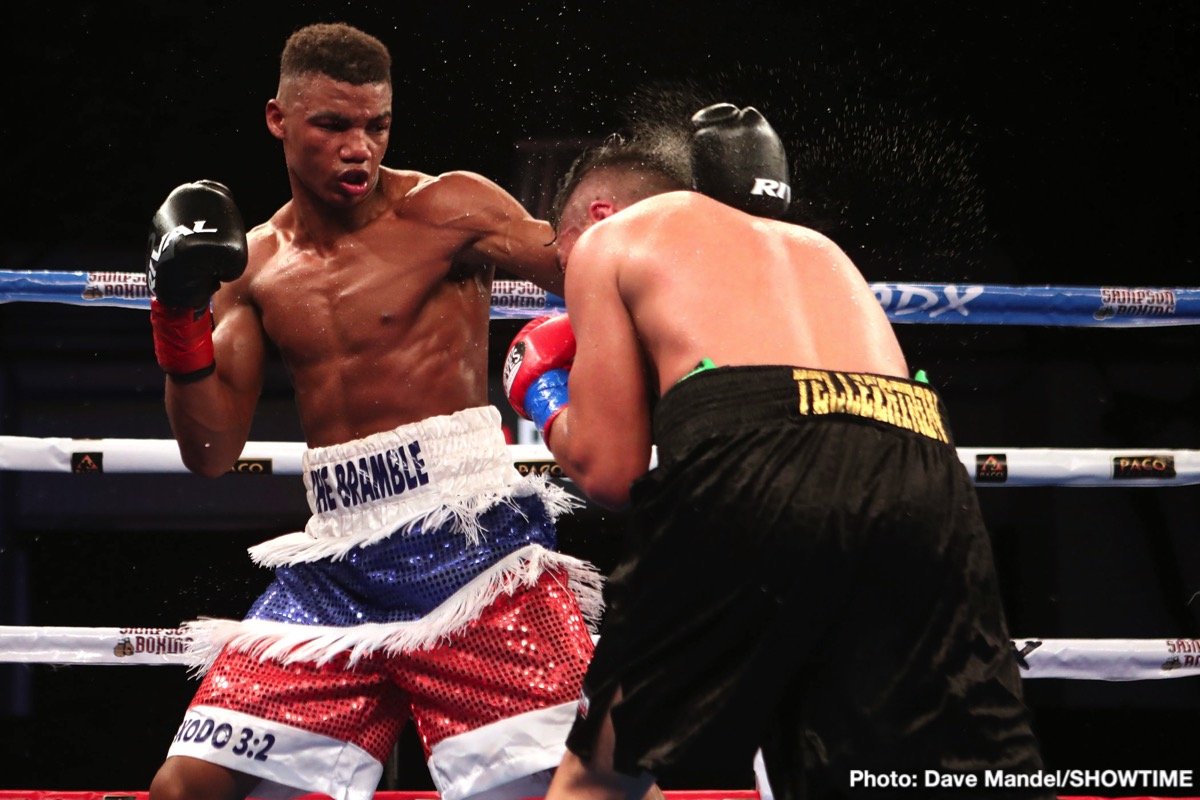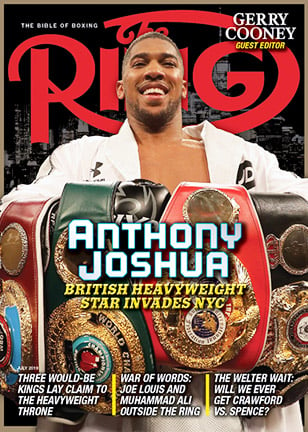The Travelin’ Man goes to Fundora vs. Zepeda: Part Two

Please click here to read Part One.
Friday, June 21 (continued): Many trainers use the threat of stopping a fight as a motivational tool that will hopefully ignite a fight-turning spark. After a desultory first two rounds against the 6-foot-5 1/2-inch junior middleweight Sebastian “The Towering Inferno” Fundora, Romulo Quirarte Jr., the experienced trainer of Hector Zepeda and the son of chief second Romulo Quirarte Sr., issued such a threat.
“I’m going to give you two rounds,” he said through translator (and Showtime analyst) Raul Marquez moments after Quirarte Sr. told Zepeda that he was doing the exact opposite of what they had trained to do. “If you don’t do it right, we might stop it.”
The CompuBox stats reveal several potential reasons behind the threat: It appeared that Team Zepeda had hoped the fighter’s mobility and defensive prowess would slow the action to a more comfortable level but the pace through the first two rounds was much more to Fundora’s liking as he averaged 80.5 punches per round while forcing Zepeda to average 62. Moreover Fundora had out-landed Zepeda 48-15 overall and 35-14 in power shots and led 30%-12% in overall accuracy and 39%-26% in power punch precision. Another negative trend: Fundora’s southpaw jab landed at a decent 19% rate (13 of 90) while Zepeda had landed just one of his 71 attempts.
The third round, especially its final 75 seconds, were no better as Fundora continued to walk Zepeda down and land his meat grinders. In all, Fundora threw 80 punches, landing 21, while Zepeda dropped from 8 of 59 in round two to 6 of 49 in round three. That’s because while Zepeda was constantly on the move, he did so from an upright stance, without sufficient upper body movement, and, far too often, to his right – directly into Fundora’s power left.
It was a bad equation for Zepeda; his defensive skills weren’t enough to neutralize Fundora’s offense and his own punching power was insufficient to keep the mantis-like Californian away. At the bell, Zepeda let out a puff of air with a look that projected puzzlement and frustration.
“You’re not doing nothing,” Quirarte Jr. told Zepeda as he sat on the stool.
“It’s like you’re scared of him,” Quirarte Sr. agreed. “This is ridiculous. We came to fight. You’re not fighting. You can’t work one single shot. You’ve got one round. That’s it!”
“Do you think he would really stop the fight?” Showtime blow-by-blow man Barry Tompkins asked Marquez.
“I don’t know,” Marquez replied. “It’s not like he’s getting beat up bad but maybe (Quirarte)’s doing that to motivate (Zepeda) to do something. But he’s a really careful trainer who cares about his fighters and he’s probably thinking, ‘Why let him keep fighting like that and get punished?’ It wouldn’t surprise me if he stops it.”
The fourth was even worse than the third as Fundora went a fight-high 28 of 95 while Zepeda went a fight-low 6 of 45. The jab numbers (7 of 52 to 3 of 27) and power figures (21 of 43, 49% to 3 of 18, 17%) were equally sobering from the Zepeda perspective.
While most other trainers would have let the fight continue – after all, Fundora hadn’t hurt Zepeda to the point of competitive extinction – the Quirartes proved they were men of their word. Even before the round was over – and moments after Fundora opened a cut over Zepeda’s right eye – Quirarte Sr. stood on the top step, poised to pull the plug on what he saw as a Quixotic venture for his fighter.

Junior middleweight Sebastian Fundora (left) vs. Hector Zepeda. Photo credit: Dave Mandel/Showtime
He ducked between the ropes, walked to referee Mark Nelson and said, in English, “It’s finished.”
“You’re finished?” Nelson asked. Still, Nelson walked to the corner to look at the clear-eyed Zepeda just in case the chief second hadn’t meant what he said.
Any question about that proposition vaporized seconds later when he said, with a horizontal wave of the arm, “Finished. Finished. No mas. No more. No mas.”
“No mas?” Nelson asked in an effort to make sure, without question, that this was the wish of the corner.
It was. “No mas. No more,” the elder trainer said.
At that, Nelson criss-crossed his arms overhead, signaling that this fight was to be recorded as a fourth-round corner retirement victory for Fundora, who raised his record to 13-0 (with 9 knockouts) while Zepeda’s fell to 17-1 (with 4 KOs).
It was an act of mercy so unusual in boxing that it required not one but eight expressions of surrender in two languages from the chief second to convince those in power that this indeed was the final decision. After all, the Quirartes’ move served to permanently remove Zepeda from the precious ranks of the undefeated, a rank that countless fighters and trainers have willingly acted to extremes to preserve. However Zepeda’s trainers opted to take a short-term setback in favor of potential long-term benefits. They knew this was an unwinnable fight for Zepeda that, if allowed to continue, could have resulted in unnecessary and potentially career-shortening damage. Zepeda, though disappointed, did not publicly object.
Did the trainers (by stopping the fight at this point) and did Zepeda (by acquiescing to his judgment of his trainers) “cheat the public” as Showtime’s Steve Farhood asked in the spirit of playing devil’s advocate and “cheat the network” as Barry Tompkins added in the same spirit? Both said, in the strictest terms, that they did. But they, along with Marquez, also agreed with the other side of the argument, which states, “Of what was the public and the network being cheated?” Based on the first four rounds, they were “cheated” of, at most, six more rounds of the same one-sided action that likely would have resulted in a 100-90 scorecard sweep and, if statistical trends had held, a fight in which Fundora would have out-landed Zepeda 243-68 in terms of overall connects and, perhaps more importantly, 178-58 in landed power punches.
As it was, Fundora led 97-27 overall, 26-4 jabs and 71-23 power while also prevailing 29%-12% overall, 16%-3% jabs and 41%-25% power. He maximized his 80-inch reach by averaging 40.5 attempted jabs per round as well as 6.5 landed jabs per round. Fundora was doing everything required to bank rounds and, had he chosen to step on the gas, he might have been able to score a late-round TKO. If anyone was “cheated” out of anything, it was Fundora as far as potentially adding to his highlight reel. That said, a win is a win and that win has earned him a return date to the ShoBox series should he and his management so choose.

Junior middleweight Sebastian Fundora. Photo credit: Dave Mandel/Showtime
“The Towering Inferno” might not have turned Zepeda into a pile of ashes but, because of a sensible act by cornermen guided by decades of combined experience, both fighters will have the opportunity to add to their resumes.
*
Perhaps the Quirartes’ decision-making was guided by what occurred in the other two televised fights – lightweight Yeis Solano’s eight-round split decision over the relentless Elias Araujo in a thrilling slugfest and lightweight Michel Rivera’s impressive eight-round dissection of the courageous Rene Tellez Giron. Solano-Araujo was a brutal two-way battle that saw a combined 1,470 punches thrown and 361 total punches landed but the southpaw Solano’s sharper hitting (30%-21% overall, 33%-22% power) and heavier shot-for-shot impact ended up inflicting a larger toll than that of the ultra-aggressive Araujo, who kept coming despite being staggered several times and being dropped near the end of round four. Yes, Araujo led in terms of raw numbers (183-178 overall) but that’s only because he averaged an incredible 109.5 punches per round to Solano’s 74.3. And despite firing 268 fewer power punches, Solano forged a narrow 173-171 lead in connects.
The decision was divided – Bob LaFratte saw Araujo a 77-74 winner but was overruled by Robert Hoyle (78-73) and Russell Mora (76-75) – and the CompuBox round-by-round breakdown of total connects (relevant because clean punching is a primary judging factor) had the fight even at 3-3-2, which means, if one adds the extra point for the knockdown, the numbers appear to agree with Mora’s one-point margin for Solano. Araujo made a terrific impression with his unyielding fighting spirit but Solano’s superior strikes rightly earned him the victory.

Lightweight Yeis Solano (left) vs. Elias Araujo. Photo credit: Dave Mandel-/Showtime
As noted by Farhood during the telecast’s second fight, Rivera, to me, bears a strong facial resemblance to a young Felix “Tito” Trinidad. But his performance against the gritty Giron offered glimpses of the youthful Trinidad in terms of style and physical assets, thanks to his generally smooth long-range boxing style combined with his ability to deliver blistering combinations. In the final moments of the contest, Rivera completed the picture by scoring a flash knockdown with a hook – which also happened to be Tito’s favorite punch.
The final numbers reflected the level of Rivera’s control as he prevailed 205-101 overall, 47-15 jabs and 158-86 power while also racking up percentage gaps of 39%-24% overall and 58%-23% power to offset Giron’s 31%-18% lead in jab accuracy. Also, Rivera led 78-55 in landed body shots.

Lightweight Michel Rivera (left) vs. Rene Tellez Giron. Photo credit: Dave Mandel/Showtime
Before anyone says, “Slow your roll,” allow me to state that I agree with that sentiment. Of course, Rivera is parsecs away from achieving Trinidad’s accomplishments, doesn’t hit with quite the same thunder, doesn’t yet project the same level of charisma (few can) and, being a Dominican, he’ll never gain a place in the hearts of Puerto Rican fans the way Tito rightfully has. The best Rivera can hope for is that his skills and future achievements will win their admiration the way other fighters from other nations have. However Rivera’s comprehensive victory over Giron was a wonderful performance from a 21-year-old who shows considerable promise and if he continues to perform in this manner against better opponents over the next several years, he might become, for Dominicans, their Tito.
*
With the end of the show at hand – and knowing that more time-sensitive work was ahead of me – I hurriedly packed my belongings, stopped backstage to grab one of the sub sandwiches Showtime provided for the crew and walked back to my second floor room in the hopes that I could get my tasks completed as quickly as possible. After all, I needed to awaken at 6:30 a.m. to give myself extra writing time before meeting my ride to Omaha – replay man Steve Bires – in the lobby at 8 a.m.
But when I tried to log onto the WinnaVegas hotel’s wireless internet, all I got was a message saying I was unable to connect. The same thing happened when I attempted to log in with my other laptop, so I knew it wasn’t a bad setting on my part. I then called the front desk and asked why the web wasn’t working and I was told the following: “When the hotel is full on the weekend, there is so much demand placed on the server that people can’t log in. Your only option is to wait until people log off before trying again.”
It was already past midnight and I told the front desk person I needed to get this work done as soon as possible. He suggested that I try the computer in the lobby, a suggestion I knew wouldn’t allow me to complete all my tasks but a better one than I had at the moment. With a shrug of the shoulders, I trudged down to the lobby with laptop in tow.
Just as I suspected, I couldn’t do what I needed to do at the computer station but while I was waiting for the wireless service to return, I spotted promoter/matchmaker Sampson Lewkowicz, promoter Paco Damian of Paco Presents and victorious fighter Yeis Solano. Although Solano wanted to shake hands, he couldn’t because, according to Lewkowicz, he injured both hands. But as painful as Solano’s fate was, I was told that Araujo felt ill in the dressing room and was taken to an area hospital as a precaution. (Note: Lewkowicz later told me that Araujo is OK, that he and the fighter will return to Argentina and that Lewkowicz will evaluate the fighter’s future).
Soon, the Wi-Fi appeared to be operational, so I excused myself, said my goodbyes and headed back to my room. After doing so, however, I discovered that, in my haste to pack my belongings, I forgot to stow the adapter that allows me to charge my cell phone through my laptop at ringside. Worse yet: When I logged into my room’s Wi-Fi, it was operating too slowly for me to upload the data into the master database. Tired and frustrated, I decided to return to the event center in the faint hope that my adapter was still there. Of course, it wasn’t – too much time had passed but the time invested in my search turned out to be beneficial because, upon my return to the room, the Wi-Fi was back at full speed. I finished my post-show tasks at 2:21 a.m., consumed my meal and finally turned out the light shortly after 3 a.m.
Saturday, June 22: Fearful that I would oversleep my 8 a.m. meeting time with Steve, I awakened at 5:30 a.m. and decided to get some writing in before heading downstairs at 7:50. Steve was waiting for me with bags at the ready, so, as soon as I finished checking out – a process that required only a few seconds because I hardly ever incur any incidentals – we were on our way to Omaha’s Eppley Airfield.
The weather forecast had been dire, so we were pleasantly surprised by the overcast sky and absence of rain. That said, the massive amount of rain that had already fallen had caused the water, at points, to advance to the edge of the interstate. When my phone signaled that I had received a text and an email within seconds of each other, I feared it was American Airlines informing me that my flight from Omaha to Charlotte had been delayed or, worse yet, cancelled. Instead it was a gentle reminder that my flight was to leave at its original time of 11:48 a.m. and that it would emanate from Gate A6.
The 90-minute drive was filled with conversation and storytelling and Steve was so absorbed by one of my tales that he missed his exit – a development for which I take full responsibility because this has happened before with other people whom have driven me over the years. No worries; Steve simply took the next exit and found his way to the gas station where he wanted to top off his rental vehicle’s tank. We arrived at Eppley in plenty of time and we said our goodbyes once we discovered that his flight was on United and mine was on American.
My first order of business was to purchase a replacement adapter for my phone. I spotted an outlet just before the security area and scanned the wall for one that would fit my phone. The young lady at the counter offered to help and, after briefly looking at my device, made her recommendation. As she gave me my receipt, I told her that I was going to see if the adapter fit my phone and that I might be back if it didn’t.
Guess what? It didn’t.
It turned out that my phone required the micro adapter, so I returned to the store, completed the exchange and purchased one that perfectly fit my phone. With that task completed, I went through security and found a seat at Gate 6A.
I spent much of my time chatting with a sales rep for a medical company, a fellow frequent flier. Using that as a starting point, I asked him his opinions about various airports, starting with the one to which we were flying: Charlotte-Douglas International Airport, one of my favorite airports.
“I don’t like it,” he replied. “If you happen to arrive in Terminal E, you have a very long walk ahead of you.”
“Good point,” I thought but, because I seldom have to deal with Terminal E, I still held a favorable view. I then asked his impression of Dallas Fort Worth International Airport, another favorite of mine.
“I don’t like that one either,” he said.
“Interesting,” I thought. I decided to switch gears by asking his opinion of Philadelphia International Airport, not high on my list because I often had to take the bus to and from Terminal F to avoid having to undergo a second security screening and also because of its daily congestion issues that often result in delayed departures.
“I don’t mind that one,” he said.
And so it went: I asked him about a half-dozen more airports and our opinions on each of them were polar opposites. However I pressed on and eventually found an airport that we agreed on: We both don’t like to fly out of JFK.
Despite our differences, we got along very well and by the time we were ready to board, we were good-natured acquaintances. The only break on our conversation occurred when I was summoned to the front desk. The reason: I was upgraded to first-class.
The flight to Charlotte proceeded flawlessly and the meal that was served in first-class (complete with chicken, a large salad, assorted nuts, a packet of flatbread and cheesecake for dessert) really hit the spot.
After landing in Charlotte at 3:18 p.m. – nine minutes earlier than advertised – I silently chuckled when the pilot told us the location of our arrival gate: E-32. Yep…Terminal E. I could almost hear my new friend’s eyes rolling.
Happily the sky in Charlotte was sunny, raising my hopes that I would be leaving for Pittsburgh in a timely and uneventful manner. But by the time I completed the long walk to Gate C-15, that sky had turned decidedly stormy. Minutes later, the dark and gray clouds began spitting out sheets of rain, yet the gate agents proceeded with the boarding process in the hopes of us beating the approaching storm.
No such luck. The 4:35 p.m. departure time was pushed back to 4:50, then 5:05, then 5:20. Our aircraft remained on the runway because the airport closed off our access point and would not reopen it until the static electricity levels in the airspace had dropped sufficiently. That process took another 40 minutes to complete. Finally at 6:05 p.m., our plane was airborne and it took just 58 minutes to touch down in Pittsburgh, where we were greeted with a sunny sky that would remain so for the duration of the day.
The drive home was free of issues and I arrived at my driveway a few minutes before my projected time of 10:15 p.m. It had been a longer-than-expected travel day, so I decided to invest the rest of the night to rest and relaxation. That will be in short supply over the next few days as I continue to address upcoming research and prepare myself for the next road trip that will begin next Friday morning. There, I will travel to Houston to chronicle, with CompuBox colleague Andy Kasprzak, a “Showtime Championship Boxing” tripleheader consisting of a WBA featherweight title eliminator between Eduardo Ramirez and Claudio Marrero, a WBC junior middleweight title eliminator between Erickson Lubin and Zakaria Attou and defense by middleweight title contender Jermall Charlo against Brandon Adams, the winner of the 2019 season of “The Contender.”
Until then, happy trails!
*
Lee Groves is a boxing writer and historian based in Friendly, West Virginia. He is a full member of the BWAA, from which he has won 16 writing awards, including two first-place awards, since 2011. He has been an elector for the International Boxing Hall of Fame since 2001 and is also a writer, researcher and punch-counter for CompuBox, Inc. He is the author of “Tales from the Vault: A Celebration of 100 Boxing Closet Classics” (available on Amazon) and the co-author of the newly released book “Muhammad Ali: By the Numbers” (also available on Amazon). To contact Groves about a personalized autographed copy, use the email [email protected] or send him a message via Facebook.
Struggling to locate a copy of The Ring Magazine? Try here or
Subscribe
You can order the current issue, which is on newsstands, or back issues from our subscribe page.

















